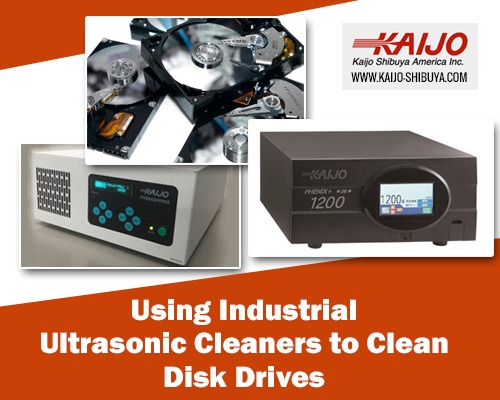Using Industrial Ultrasonic Cleaners to Clean Disk Drives
May 23, 2019
 Disk drive components such as the aluminum disk platter blanks and the metal read/write heads are manufactured in standard industrial facilities. The processes for their fabrication include stamping, machining, punching, polishing and molding using industrial chemicals for cooling, lubrication and as abrasives. Although most of these chemicals are removed in the final stages of manufacturing, they leave traces that can severely affect hard disk drive performance.
Disk drive components such as the aluminum disk platter blanks and the metal read/write heads are manufactured in standard industrial facilities. The processes for their fabrication include stamping, machining, punching, polishing and molding using industrial chemicals for cooling, lubrication and as abrasives. Although most of these chemicals are removed in the final stages of manufacturing, they leave traces that can severely affect hard disk drive performance.
Disk drive component finishing and hard drive assembly are carried out in special facilities that have high levels of cleanliness and a minimized exposure to contaminants. Before they can be used in such a facility, the hard drive components arriving from the industrial manufacturer have to be cleaned thoroughly. Traces of the industrial chemicals, contaminants added during shipment and particles adhering to platter surfaces have to be removed completely. High performance industrial ultrasonic cleaners can perform these types of cleaning tasks quickly and effectively.
How Ultrasonic Systems Clean Hard Drive Components
Ultrasonic cleaners produce microscopic cavitation bubbles in the solution of a cleaning tank. The bubbles form and collapse in time with the ultrasonic frequency. When a bubble collapses near the surface of a hard disk platter or a disk head, it produces a scrubbing action that removes contaminants and dislodges particles. The bubbles form wherever the cleaning solution can penetrate, even around the irregular shape of a disk read/write head.
The surface of a hard disk platter is machined and polished to be completely smooth while disk heads have a delicate physical structure. The heavy contamination with industrial chemicals removed at the manufacturing plant left remaining traces that don’t require robust cleaning action. Higher ultrasonic frequencies produce gentle cleaning because their cavitation bubbles are smaller and less energetic. Cleaning frequencies of up to 400 kHz to 1MHz help protect the smooth platter surface and the delicate heads from damage while still delivering cleaning action that can remove trace contaminants and particles completely.
High Cleanliness Needs Require Special Cleaning Measures
The components of hard disk drives have to be especially clean because the heads float very closely over the platters and the magnetic coating has to be completely even. If contaminants or particles remain on the platters, the path of the floating heads might be disturbed or the magnetic coating might contain defects. If the heads don’t float properly, they may crash into the platters, damaging the magnetic coating. If the coating is not defect-free, some data stored in it may be lost.
To achieve complete cleanliness, hard disk drive manufacturers often use several frequencies to clean different components and to remove specific contaminants. The preferred cleaning solution is pure water because cleaning agents leave traces that then have to be removed as well. For some lubricants, a mild detergent and/or heating the cleaning solution may make complete removal easier.
Lower frequencies can be used for the read/write heads because their surface is hard metal but platters sometimes have soft surfaces due to surface treatments. Higher frequencies are called for to clean delicate platters. Within the high-frequency range, platters can first be cleaned at lower frequencies to remove contaminants. The highest frequencies are ideal for removing the last few microscopic particles before the platters are turned into hard disk drives.
Kaijo Has Ultrasonic Cleaners Ideal for Disk Drive Cleaning
Kaijo offers free consulting to help customers choose industrial ultrasonic cleaners that meet their needs. Whether multi-frequency or single frequency hard disk drive cleaning is needed, Kaijo can analyze customer requirements and suggest systems from their complete line of ultrasonic cleaning equipment. Ultrasonic cleaning systems can be turn key or individual components such as ultrasonic generators or transducers that can be supplied to fit into existing production lines.





